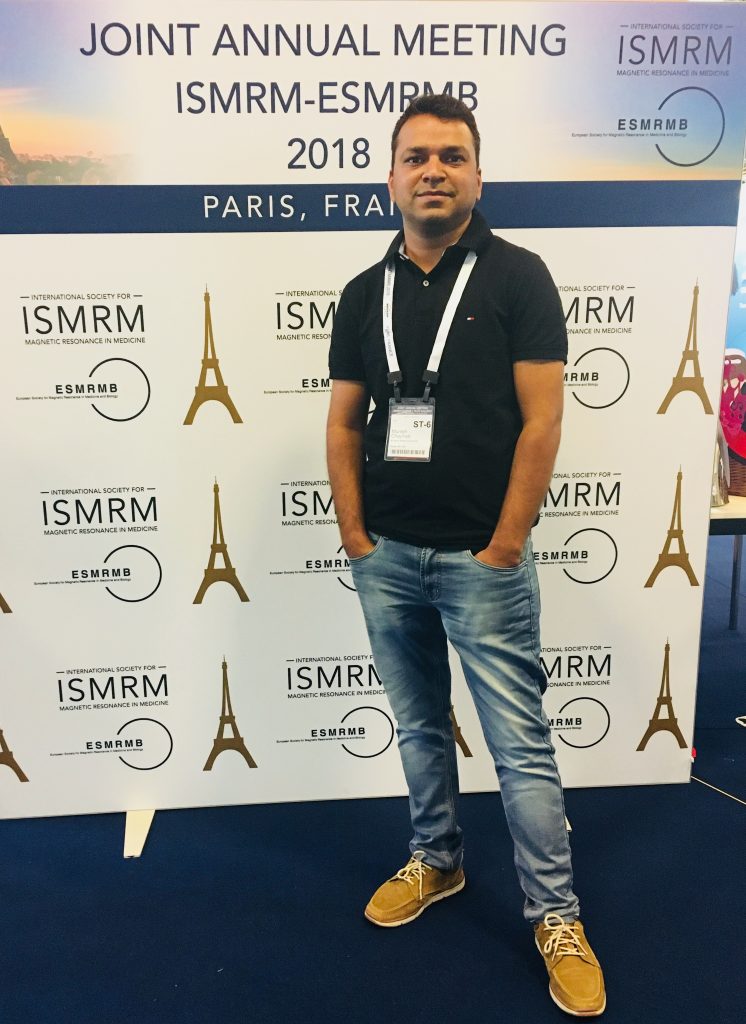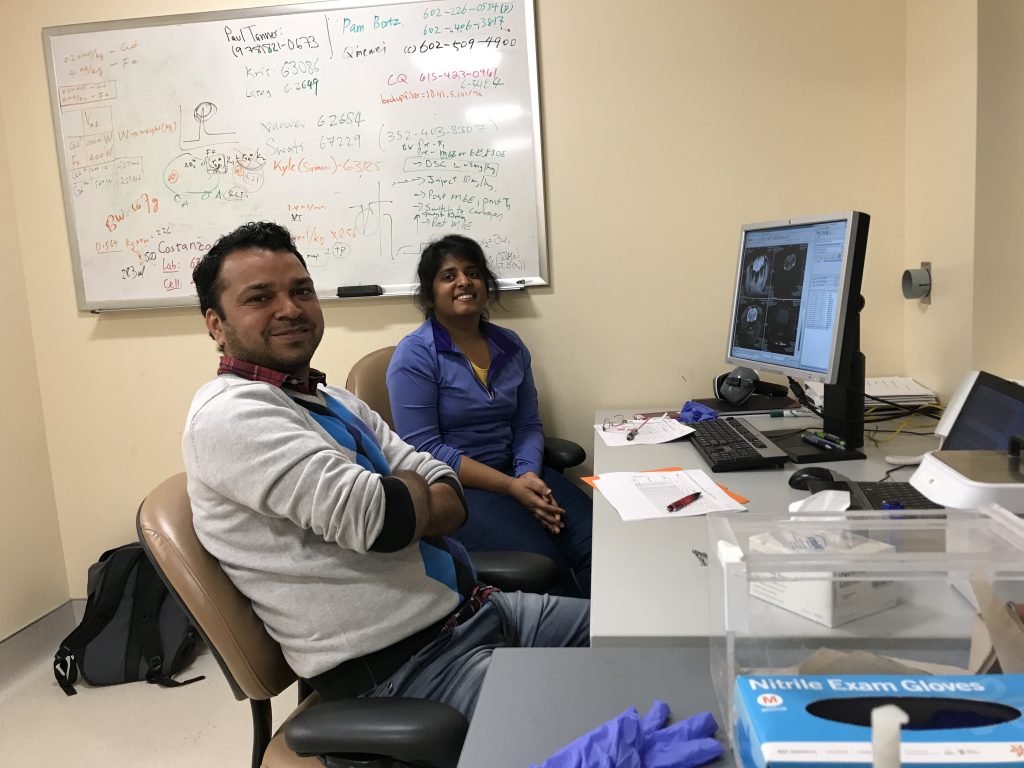 By Jiaen Liu
By Jiaen Liu

Rosalind Sadleir and Munish Chauhan are old friends of Highlights. In our previous interview with them we found out about their career paths and their work on multi-shot echo-planar MR-based electrical impedance tomography (MREIT). They recently published a new paper in MRM in which they theoretically investigated the effect size of tissue conductivity changes caused by neural activity and the feasibility of measuring these changes using MREIT.
MRMH: Could you briefly introduce the history of brain activity measurement based on electrical impedance changes?
Rosalind: It has been shown that changes in voltage across cell membranes in active brain tissue caused by either intrinsic internal sources or externally administered current can be measured. But one aspect that has been overlooked is the changes in cell membrane conductance that occur around the same time as these membrane voltage changes. Inactive neuronal cell membranes are more isolating to the passage of an external electrical current than the membranes of active cells. This idea, studied through the fast neural electrical impedance tomography (EIT) technique, has been around in the field for almost thirty years. With this technique, very subtle conductivity changes related to brain activity can be monitored using an electrode array. But experimental evidence has shown that it is necessary to remove the skull of the animal, and even use implanted electrodes, in order to measure these changes practically. We took this neuroimaging concept from EIT and adapted it to the field of MRI-based electrical property imaging. Basically, we measure the conductivity changes on the basis of MR signal phase changes, using the so-called MREIT method. This method has the significant advantage of allowing us to measure the signals not only noninvasively but also in the particular tissue we are interested in.
Munish: This idea is an extension of previous neural current density imaging attempts using MRI. People have tried using MRI to directly measure neural currents, which change the B0 field and therefore MR phase images. But the problem is that the extremely small neural currents only generate magnetic field changes at around the 10-12 Tesla level, which is difficult to detect above the noise floor. We use externally injected current to boost the small phase changes caused by changes in membrane conductance. The external current pathways and therefore recovered phase images change because of the slight cell membrane conductance changes occurring with activity. The amplification is related to the external current magnitude.
MRMH: Do your results confirm previous findings in similar fields?
Rosalind: In the field of neural current MRI, I do not believe there have been any reports of successful in vivo experiments, although effects have been observed in vitro. Even if it is possible to somehow boost the very small signal above the noise floor, there remains the considerable problem of cancellation of the fields caused by the various electrical dipole orientations within a voxel. The conductance contrast we work with does not have this issue. More brain activity should increase the conductance. We have verified the existence of our contrast in vitro, and we are presently preparing in vivo work.
MRMH: For the in vivo situation, do you anticipate any interference of the external current with the neural activity?
Rosalind: It’s very likely that any injected current will change the level of activity. We therefore always assume that when you have intrinsic activity and apply MREIT imaging currents, this will change the activity in some way. Basically, the way to test this technique, as we have done in our studies, is to compare this effect on the activity both with and without other treatment. For example, in our in vitro study, we compared spontaneous activities in ‘Aplysia sea slug’ when the animal underwent MREIT both with and without potassium chloride treatment. In that case potassium chloride increased the spontaneous activity level compared with the control medium.

Munish: The technique can also be tested using optical manipulation, on salamander retina cells, for example. In this case, we can synchronize the optical stimulus with the MREIT current, whereas activities from Aplysia are spontaneous. We can concentrate the activity in response to the light just at the time we apply the imaging current.
MRMH: What else can you tell us, broadly, about your lab’s work?
Munish: In another project, we image current density distributions in the human brain during transcranial direct current stimulation (TDCS) using MREIT methods. During TDCS, current is applied to the scalp and stimulates the brain. The reason we are interested in observing current distribution during TDCS is that it may help us to better understand the mechanism of its effect on the brain. The beauty of this method is that it also allows us to combine DTI and MREIT data in order to calculate the conductivity tensor of the brain in vivo. In addition, we are working on using the multiband technique in order to accelerate this data acquisition and thus cover more of the brain. We have found that subjects do not usually enjoy having the (MREIT) imaging currents applied for too long inside the scanner.
Rosalind: In the TDCS field, people want to concentrate the current on a particular structure, but have mostly relied on computational models in order to figure out where to place the electrodes. We are seeking to move this field forward by measuring an individual’s conductivity distributions in order to better define the electrode positions. In addition, our approach might also benefit a field called EEG-based source imaging, which locates sources in the brain from EEG recordings, but needs correct conductivity distributions for accurate reconstructions.

MRMH: What do you see as the possible in vivo applications of your methods?
Rosalind: In principle, MREIT-based functional imaging could be a useful alternative to BOLD fMRI. It provides a more direct indication of neural activity than BOLD does, and with similar resolution. Also, it could exploit existing fMRI analysis pipelines to analyze statistical differences based on our contrast. However, when working in vivo, we also need to consider the effect of blood flow changes, which can change the conductivity of a tissue. We might exploit the different temporal scales of the two approaches to address this potential problem. For example, we can saturate the BOLD response or observe the conductivity changes before blood flow effects appear. We are also working on boosting the SNR by using either high-field or implanted DBS electrodes in order to obtain larger or phase changes. We may end up using carbon electrodes to get rid of the susceptibility artifacts caused by metal electrodes.
MRMH: What’s your advice for people starting to work in this field?
Munish: Our collaborator in Korea published a paper in IEEE (Sajib et al., IEEE TMBE, 2017) that introduced the principle of MREIT and current density imaging, and they have also established an open source Matlab toolbox. People will need expertise in MRI and electrical engineering to work in this field. But in many ways it’s less complicated than the related EIT field, since MRI can provide information on current flow inside the brain.





Great Job Munish. You are making us extremely proud. Keep it up.
Comments are closed.